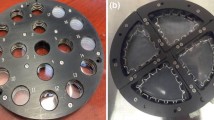Abstract
It has been shown that incorporation of TiO2 nanoparticles into hydrophobic coatings can show self-cleaning performance. Accelerated laboratory testing indicated that the coats retain their hydrophobic nature for an extended time period. In this paper, hydrophobic polydimethylsiloxane (PDMS)/TiO2 nanocomposite coatings with a TiO2 content of 0–40% were fabricated by simple blending of a PDMS dispersion with an aqueous TiO2 nanoparticle dispersion. Their long-term hydrophobicity and self-cleaning performance were investigated both in laboratory and real-world outdoor testing. As expected, TiO2 nanoparticle-based coatings exhibited better self-cleaning relative to the TiO2-free PDMS control coating as measured by methylene blue degradation testing. Excellent long-term hydrophobicity was observed in accelerated weathering testing when they contained the appropriate levels of TiO2 nanoparticles (i.e., 0–30%). However, the same PDMS/TiO2 coatings did not show self-cleaning performance, and instead, exhibited improved dirt pickup resistance, in outdoor exposure testing. Sustained hydrophobicity was observed in outdoor exposure testing for the clear films except when TiO2 levels were at 40%. The hysteresis of water contact angle (HWCA) significantly increased for the PDMS control coating, and water beading was lost as the film surface picked up dirt. In contrast, the TiO2-based coatings with appropriate TiO2 levels maintained a relatively low HWCA after outdoor exposure and no water sheeting on rainy days was observed. This result demonstrates that while photocatalytic TiO2 nanoparticles can maintain coating hydrophobicity upon outdoor exposure, long-term self-cleaning performance in polluted environments has not yet been achieved with this type of coating under real-world conditions.









Similar content being viewed by others
References
Hu, Z, Zhang, X, Liu, Z, Huo, K, Chu, PK, Zhai, J, Jiang, L, “Regulating Water Adhesion on Superhydrophobic TiO2 Nanotube Arrays.” Adv. Funct. Mater., 24 (40) 6381–6388 (2014)
Pang, H, Zhou, S, Gu, G, Wu, L, “Long-Term Hydrophobicity and Ice Adhesion Strength of Latex Paints Containing Silicone Oil Microcapsules.” J. Adhes. Sci. Technol., 27 (1) 46–57 (2013)
Gao, S-H, Lei, M-K, Liu, Y, Wen, L-S, “CF4 Radio Frequency Plasma Surface Modification of Silicone Rubber for Use as Outdoor Insulations.” Appl. Surf. Sci., 255 (11) 6017–6023 (2009)
Qing, Y, Yang, C, Sun, Y, Zheng, Y, Wang, X, Shang, Y, Wang, L, Liu, C, “Facile Fabrication of Superhydrophobic Surfaces with Corrosion Resistance by Nanocomposite Coating of TiO2 and Polydimethylsiloxane.” Colloids Surf. A: Physicochem. Eng. Aspects, 484 471–477 (2015)
Ragesh, P, Anand Ganesh, V, Nair, SV, Nair, AS, “A Review on ‘Self-Cleaning and Multifunctional Materials’.” J. Mater. Chem. A, 2 (36) 14773–14797 (2014)
Tung, WS, Daoud, WA, “Self-Cleaning Fibers via Nanotechnology: A Virtual Reality.” J. Mater. Chem., 21 (22) 7858–7869 (2011)
Ganesh, VA, Raut, HK, Nair, AS, Ramakrishna, S, “A Review on Self-Cleaning Coatings.” J. Mater. Chem., 21 (41) 16304–16322 (2011)
Teisala, H, Tuominen, M, Kuusipalo, J, “Superhydrophobic Coatings on Cellulose-Based Materials: Fabrication, Properties, and Applications.” Adv. Mater. Interfaces, 1 (1) 1–20 (2014)
Sahoo, BN, Kandasubramanian, B, “Recent Progress in Fabrication and Characterisation of Hierarchical Biomimetic Superhydrophobic Structures.” RSC Adv., 4 (42) 22053–22093 (2014)
Mahadik, SA, Pedraza, F, Vhatkar, RS, “Silica Based Superhydrophobic Coating for Long-Term Industrial and Domestic Applications.” J. Alloys Compd., 663 487–493 (2016)
Li, S, Gu, G, Zhou, S, Wu, L, “Dependence of Dirt Resistance of Steel Topcoats on Their Surface Characteristics.” J. Coat. Technol. Res., 10 (3) 339–346 (2012)
Wooh, S, Encinas, N, Vollmer, D, Butt, HJ, “Stable Hydrophobic Metal-Oxide Photocatalysts via Grafting Polydimethylsiloxane Brush.” Adv. Mater., 29 (16) 1–7 (2017)
Ding, X, Zhou, S, Gu, G, Wu, L, “A Facile and Large-Area Fabrication Method of Superhydrophobic Self-Cleaning Fluorinated Polysiloxane/TiO2 Nanocomposite Coatings with Long-Term Durability.” J. Mater. Chem., 21 (17) 6161–6164 (2011)
Chen, K, Zhou, S, Yang, S, Wu, L, “Fabrication of All-Water-Based Self-Repairing Superhydrophobic Coatings Based on UV-Responsive Microcapsules.” Adv. Funct. Mater., 25 (7) 1035–1041 (2015)
Peter, G, “Modified Silica Sols: Titania Dispersants and Co-binders for Silicate Paints.” Pigment Resin Technol., 39 (6) 315–321 (2010)
Wada, T, Inui, K, Uragami, T, “Properties of Organic–Inorganic Composite Materials Prepared from Acrylic Resin Emulsions and Colloidal Silicas.” J. Appl. Polym. Sci., 101 (3) 2051–2056 (2006)
Zhang, S, Zhou, S, You, B, Wu, L, “Fabrication of Ordered Porous Polymer Film via a One-Step Strategy and Its Formation Mechanism.” Macromolecules, 42 (10) 3591–3597 (2009)
You, B, Wen, N, Zhou, S, Wu, L, Zhao, D, “Facile Method for Fabrication of Nanocomposite Films with Ordered Porous Surface.” J. Phys. Chem. B, 112 7706–7712 (2008)
Yang, L, Zhou, S, Gu, G, Wu, L, “Film-Forming Behavior and Mechanical Properties of Colloidal Silica/Polymer Latex Blends with High Silica Load.” J. Appl. Polym. Sci., 129 (3) 1434–1445 (2013)
Novotná, P, Zita, J, Krýsa, J, Kalousek, V, Rathouský, J, “Two-Component Transparent TiO2/SiO2 and TiO2/PDMS Films as Efficient Photocatalysts for Environmental Cleaning.” Appl. Catal. B: Environ., 79 (2) 179–185 (2008)
Wang, R, Hashimoto, K, Fujishima, A, “Light-Induced Amphiphilic Surfaces.” Nature, 388 (6641) 431–432 (1997)
Li, Y-F, Wu, C-J, Sheng, Y-J, Tsao, H-K, “Facile Manipulation of Receding Contact Angles of a Substrate by Roughening and Fluorination.” Appl. Surf. Sci., 355 127–132 (2015)
Acknowledgments
This work was financially supported by The Dow Chemical Company.
Author information
Authors and Affiliations
Corresponding author
Electronic supplementary material
Below is the link to the electronic supplementary material.
Rights and permissions
About this article
Cite this article
Xu, F., Wang, T., Bohling, J. et al. Extended hydrophobicity and self-cleaning performance of waterborne PDMS/TiO2 nanocomposite coatings under accelerated laboratory and outdoor exposure testing. J Coat Technol Res 15, 1025–1034 (2018). https://doi.org/10.1007/s11998-017-0037-0
Published:
Issue Date:
DOI: https://doi.org/10.1007/s11998-017-0037-0




